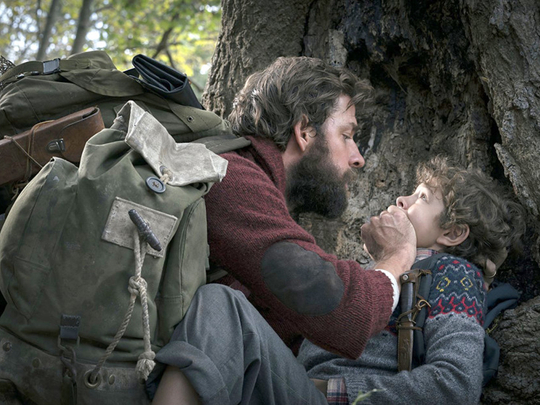
Horror, it seems, will never die. The undermining of traditional releasing strategies by Netflix premieres and simultaneous releases of movies in cinemas and on demand has led to Hollywood anxiously doubling down on safe sequels, reboots and expanded universes. Yet a legion of smart, subversive and downright scary horror movies has been packing them in.
Look at the barnstorming success of A Quiet Place, the pin-drop survival thriller where John Krasinski and his Little House on the Prairie clan live in tiptoeing fear of hunter-killer beasties who are hypersensitive to sound. It’s a supremely crafted, allegorically rich nerve-jangler that forces audiences to shut the hell up or be complicit in the razor-clawed slaughter. From a $17 million (Dh62.42 million) budget, A Quiet Place brought in a boisterous $50m in its first weekend, making it Paramount’s biggest opening since Star Trek Beyond, an expensive blockbuster sequel that cost $175 million.
This is not some quick-and-dirty exploitation movie: A Quiet Place has been almost universally praised by critics, to the extent that blockbuster overlord Michael Bay, who shepherded the project through his Platinum Dunes production arm, took to Instagram to drily note that the movie’s sky-high Rotten Tomatoes score was “a first for my company.”
Even after horror’s banner year in 2017 — with hot-button word-of-mouth Oscar-winner Get Out, M Night Shyamalan’s unexpectedly career-reviving Split and the $700 million global success of It’s killer clown showreel — this feels like an intriguing new benchmark.
Like comedies, horror movies have always been enriched by being a communal experience where you can hear other patrons gasp or nervously giggle in the dark, which may help explain their multiplex resilience in the on-demand home entertainment era. It has been more than two decades since Scream built a quadrilogy around the idea that everyone had long absorbed the rules of slasher films.
So for writers and directors, the challenge is to come up with something that horror fans — loyal but often seemingly insatiable — have not seen or experienced before. At its best, the genre is in a constant state of reinvention, helped by the fact that low-production budgets can be fertile ground for high-risk storytelling.
While the creative talent may be attracted by opportunities to try something new, horror’s continuing appeal to producers and studios is baser: audiences have always been more jazzed by creepy concepts or masked monsters than recognisable (and costly) stars. The genre also has a fine tradition of performing uncanny box office jujitsu, transforming bargain-basement shockers into hits with enviable profit multipliers.
The most impressive 21st-century case study is still 2007’s Paranormal Activity, the security-cam poltergeist chiller that spun an $11,000 budget into a $200 million phenomenon, giving birth to a franchise in the process. That low-budget titan was a defining hit for Jason Blum and Blumhouse Productions, horror specialists with a knack for steering movies with slim budgets into profitable successes by nurturing talent and canny marketing. The Blumhouse catalogue includes Get Out, Split, Happy Death Day and the Insidious, Sinister and Purge franchises: conspicuously well-made movies that often splice social commentary into their scares.
A Quiet Place feels like a conscious attempt by Paramount to ape the Blumhouse blueprint, much like A24, another fleet and industrious production company, which has achieved critical inroads with idiosyncratic horror-adjacent movies such as The Witch, A Ghost Story and It Comes at Night.
(They’re also distributing Toni Colette-starring shocker Hereditary, which is already being talked up as one of the year’s scariest horror films). Should Blumhouse be worried that it is being stalked? The company seems focused on its own typically busy production and release slate for 2018. As well as a handshake deal with Oscar-nominated Dee Rees to make a horror movie, other irons in the fire include urban vampire tale Family Blood, a new project from Saw and Insidious writer Leigh Whannell, and a sequel to Halloween.
Reactivating John Carpenter’s classic slasher franchise feels like a way to align Blumhouse with horror’s blue-chip-properties past but it has just as much confidence in its self-generated material. The First Purge, a prequel to the lawlessness franchise that echoes and intensifies America’s national conversation about violence and gun control, has cheerfully squatted on the July 4 release date that was traditionally home to Will Smith blockbusters.
The Purge gimmick is that, for one evening, its characters can do whatever they like. The best current horror film-makers seem to have taken the ‘anything goes’ ethos to heart.












